
Royal Botanic Gardens, Kew, is a non-departmental public body in the United Kingdom sponsored by the Department for Environment, Food and Rural Affairs. An internationally important botanical research and education institution, it employs 1,100 staff. Its board of trustees is chaired by Dame Amelia Fawcett.
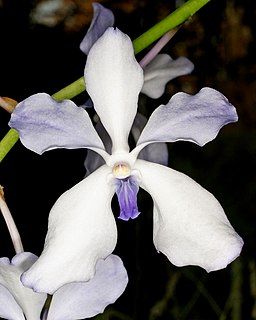
Vanda, abbreviated in the horticultural trade as V., is a genus in the orchid family, Orchidaceae. There are about 80 species, and the genus is commonly cultivated for the marketplace. This genus and its allies are considered to be among the most specifically adapted of all orchids within the Orchidaceae. The genus is highly prized in horticulture for its showy, fragrant, long-lasting, and intensely colorful flowers. Vanda species are widespread across East Asia, Southeast Asia, and New Guinea, with a few species extending into Queensland and some of the islands of the western Pacific.
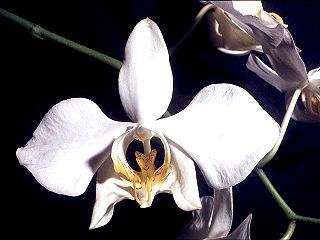
PhalaenopsisBlume (1825), commonly known as moth orchids, is a genus of about seventy species of plants in the family Orchidaceae. Orchids in this genus are monopodial epiphytes or lithophytes with long, coarse roots, short, leafy stems and long-lasting, flat flowers arranged in a flowering stem that often branches near the end. Orchids in this genus are native to India, Taiwan, China, Southeast Asia, New Guinea and Australia with the majority in Indonesia and the Philippines.

Acampe, abbreviated as Acp in horticultural trade, is a genus of monopodial, epiphytic vandaceous species of orchids, distributed from tropical Asia from India, eastwards to China and southwards to Malaysia, and the Philippines as well as from tropical Africa, Madagascar and islands of the Indian Ocean. The name Acampe was derived from the Greek word akampas, meaning "rigid", referring to the small, brittle, inflexible flowers.

× Ascocenda, abbreviated as Ascda in the horticultural trade, was a man-made hybrid orchid genus resulting from a cross between the former genus Ascocentrum and Vanda. It was first described in Orchid Rev. 57: 172 (1949). Ascocentrum is now synonymous with Vanda, so the name is obsolete. Hybrids in the nothogenus × Ascocenda are now properly termed Vanda.

Muscari is a genus of perennial bulbous plants native to Eurasia that produce spikes of dense, most commonly blue, urn-shaped flowers resembling bunches of grapes in the spring. The common name for the genus is grape hyacinth, but they should not be confused with hyacinths. In the United States, they are also commonly referred to as bluebells, though certain regions reserve this name for bluebonnets instead. A number of species of Muscari are used as ornamental garden plants.

Pachystoma, commonly known as kunai orchids or 粉口兰属 , is a genus of two species of flowering plants in the orchid family, Orchidaceae. They are deciduous, terrestrial herbs with one or two linear, pleated or veiny leaves and more or less drooping flowers which do not open widely, on a thin, wiry flowering stem. Species in this genus are found in tropical and subtropical Asia to Australia and islands of the southwest Pacific Ocean.
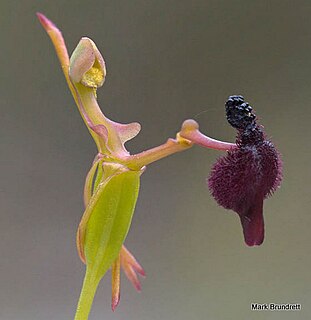
Drakaea is a genus of 10 species in the plant family Orchidaceae commonly known as hammer orchids. All ten species only occur in the south-west of Western Australia. Hammer orchids are characterised by an insectoid labellum that is attached to a narrow, hinged stem, which holds it aloft. The stem can only hinge backwards, where the broadly winged column carries the pollen and stigma. Each species of hammer orchid is pollinated by a specific species of thynnid wasp. Thynnid wasps are unusual in that the female is flightless and mating occurs when the male carries a female away to a source of food. The labellum of the orchid resembles a female thynnid wasp in shape, colour and scent. Insect pollination involving sexual attraction is common in orchids but the interaction between the male thynnid wasp and the hammer orchid is unique in that it involves the insect trying to fly away with a part of the flower.
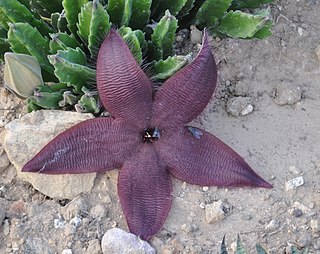
Stapelia grandiflora is a species of flowering plant in the genus Stapelia of the family Apocynaceae. It is commonly referred to as the carrion plant, starfish flower, giant toad plant, or starfish cactus, although it is not related to cacti at all. This "carrion plant" nickname can also refer to similar Stapelia species as well as members of related genera, including Stapelia gigantea and Orbea variegata. Stapelia grandiflora sometimes also goes by the name of Stapelia flavirostris. The plant is native to South Africa, including the Northern Cape, Eastern Cape, and Free State.

Sarcochilus, commonly known as butterfly orchids or fairy bells is a genus of about twenty species of flowering plants in the orchid family, Orchidaceae. Most species are epiphytes but a few species only grow on rocks or in leaf litter. Orchids in this genus usually have short stems, leaves arranged in two rows and flowers arranged along unbranched flowering stems. Most species are endemic to Australia but some are found in New Guinea and New Caledonia.

Luisia, commonly known as velvet orchids or 钗子股属 , is a genus of epiphytic or lithophytic orchids in family Orchidaceae. Plants in this genus have flattened roots, long leafy stems, narrow, thick, leathery leaves and short-lived flowers that open sporadically. There are about forty species found from tropical and subtropical Asia to the Western Pacific.
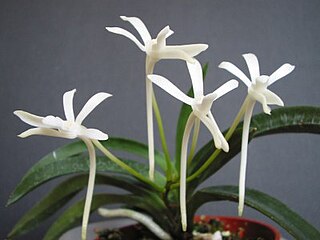
Neofinetia was a genus of flowering plants from the orchid family, Orchidaceae, that is now classified as a Vanda. It contained three species and was distributed in China, Korea, and Japan.

× Aeridovanda, abbreviated in trade journals Aerdv, is an intergeneric hybrid between the orchid genera Aerides and Vanda. It is now the accepted name for several former hybrid genera, since Ascocentrum and Neofinetia are now both synonymous with Vanda.
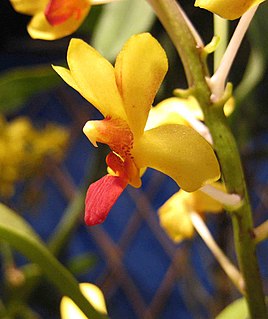
× Vandaenopsis, abbreviated Vdnps. in the horticultural trade, is an intergeneric hybrid between the orchid genera Phalaenopsis and Vanda. It is now the accepted name for several former hybrid genera, since Ascocentrum and Neofinetia are now both synonymous with Vanda.
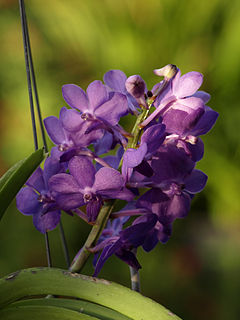
×Vandachostylis, abbreviated Van. in the horticultural trade, is the nothogenus for intergeneric hybrids between the orchid genera Rhynchostylis and Vanda. It is now the accepted name for several former hybrid genera, such as × Vascostylis and × Neostylis, since Ascocentrum and Neofinetia are now both synonymous with Vanda.

Dendrobium bigibbum, commonly known as the Cooktown orchid or mauve butterfly orchid, is an epiphytic or lithophytic orchid in the family Orchidaceae. It has cylindrical pseudobulbs, each with between three and five green or purplish leaves and arching flowering stems with up to twenty, usually lilac-purple flowers. It occurs in tropical North Queensland, Australia and New Guinea.

Acer heldreichii is a species of flowering plant in the Sapindaceae family. It is referred to by the common names Heldreich's maple, Mountain Maple, Greek maple, and Balkan maple is a European species of maple. It is native to Albania, Bulgaria, Greece, North Macedonia, Montenegro, Kosovo, Serbia, and Bosnia-Herzegovina.
The World Checklist of Selected Plant Families is an "international collaborative programme that provides the latest peer reviewed and published opinions on the accepted scientific names and synonyms of selected plant families." Maintained by the Royal Botanic Gardens, Kew, it is available online, allowing searches for the names of families, genera and species, as well as the ability to create checklists.
Disperis nitida is a species of plants endemic to Cameroon which is found in two locations - Manengouba and in the mountainous region of Bamenda. In decline due to deforestation of its unprotected habitat, it is evaluated as a species in critical danger of extinction.
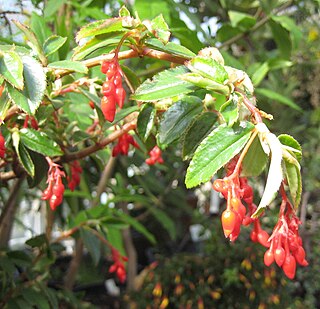
Begonia fuchsioides, the fuchsia begonia, is a species of flowering plant in the family Begoniaceae. It is native to Ecuador, Colombia, and western Venezuela, and has been introduced to Hawaii and Réunion. A small bush reaching 2 ft (60 cm), it is hardy to USDA zone 10a.


















